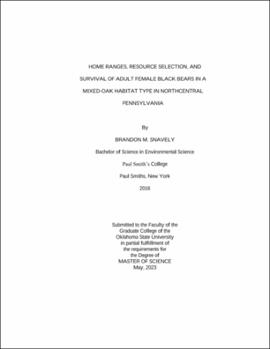| dc.contributor.advisor | Lonsinger, Robert C. | |
| dc.contributor.author | Snavely, Brandon M. | |
| dc.date.accessioned | 2023-08-25T20:06:33Z | |
| dc.date.available | 2023-08-25T20:06:33Z | |
| dc.date.issued | 2023-05 | |
| dc.identifier.uri | https://hdl.handle.net/11244/338964 | |
| dc.description.abstract | From 2019–2021, hunting seasons for American black bears (Ursus americanus) in Pennsylvania increased in length and changed in structure compared to prior years. Factors that influence bear harvest vulnerability during these expanded hunting seasons are unknown. Fall movement patterns of bears vary annually and may depend on fall hard mast availability. Understanding the variability in movements among bears throughout hunting seasons and their fates can inform management. We trapped and GPS-collared adult female bears in the Sproul State Forest in northcentral Pennsylvania from 2019–2021 to determine home range sizes, patterns of resource selection, and sources of mortality. We assessed the relative abundance of fall hard mast to characterize annual variability in mast availability. We evaluated temporal and spatial variation in hunter activity with road-side surveys and remote trail cameras, respectively. Beginning 1 September, we estimated fall and weekly home range size with utilization distributions through an autocorrelated kernel density estimation and evaluated the influence of predictors hypothesized to influence third-order resource selection through generalized linear mixed models. We investigated factors hypothesized to influence survival during bear hunting seasons with known-fate models. Mean fall home range size was 248.7 km² (range = 6.1–2636.1 km²). Home range size varied by year and were generally smaller during archery harvest season than other periods. Patterns of weekly resource selection indicated bears shifted their space use to areas with lower elevations and steeper slopes during hunting seasons. Bears selected for areas containing oak trees throughout the fall. Survival was lower in older age bears, higher relative mast abundance conditions, steeper slopes, and areas of greater hunter space use during the general firearms season. Survival was higher in areas of greater hunter space use during archery season. Harvest rate of adult female bears was 0.345 in 2019, 0.321 in 2020, and 0.150 in 2021, and averaged 0.272 across all three years. The probability of an adult female black bear surviving all harvest seasons each year was 0.611 (SE = 0.086, 95% CI = 0.436, 0.761). The high harvest rate and low predicted survival may lead to population reduction. | |
| dc.format | application/pdf | |
| dc.language | en_US | |
| dc.rights | Copyright is held by the author who has granted the Oklahoma State University Library the non-exclusive right to share this material in its institutional repository. Contact Digital Library Services at lib-dls@okstate.edu or 405-744-9161 for the permission policy on the use, reproduction or distribution of this material. | |
| dc.title | Home ranges, resource selection, and survival of adult female black bears in a mixed-oak habitat type in northcentral Pennsylvania | |
| dc.contributor.committeeMember | Fairbanks, W. Sue | |
| dc.contributor.committeeMember | Chitwood, M. Colter | |
| dc.contributor.committeeMember | Lovallo, Matthew J. | |
| osu.filename | Snavely_okstate_0664M_18143.pdf | |
| osu.accesstype | Open Access | |
| dc.type.genre | Thesis | |
| dc.type.material | Text | |
| dc.subject.keywords | black bear | |
| dc.subject.keywords | home range | |
| dc.subject.keywords | resource selection | |
| dc.subject.keywords | survival | |
| thesis.degree.discipline | Natural Resources and Ecology Management | |
| thesis.degree.grantor | Oklahoma State University | |
